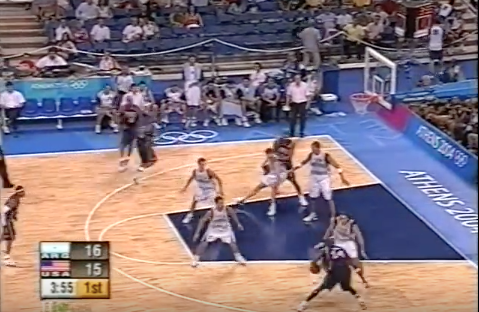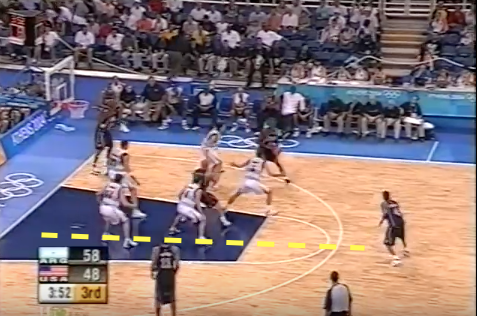As the Olympics begin the consensus is that the US team won’t be subjected to anything more than a brief sweat as they romp to Gold. To even debate that France or Spain to seriously push them for 40 minutes has become tantamount to ‘views on the shape of the earth differ’ - largely for the same reason, because there is overwhelming evidence for only one side of the ‘debate’.
We certainly won’t be disagreeing, although mainly because a squad of the depth and quality of Spain 2008 or 2012 just isn’t present. The generation of Juan Carlos Navarro, Manu Ginobili and Tony Parker is fading and the talent coming through is diffused throughout the world; not all of it is even present in Rio (hi, Canada). The most interesting thing for most American fans this summer might be parsing the body language of new teammates Kevin Durant, Klay Thompson and Draymond Green. That and whoever messes with Boogie Cousins, and whether they ever find a body.
So in the absence of anything better to talk about, how about looking back to the nadir of the US programme, back in 2004 when they only took home a bronze medal, with only a 5-3 record.
There’s a phenomenal oral history of the fall and rise of the US NT over at NBC Sports, which touches on how the game done changed since the early 00s, or rather how much the American team, carrying through the prevailing trend in the NBA, has become so much more Eurocentric. In this case we’re stretching that term to include an Argentine side that mostly came through European clubs and in many cases had a passport to show for their old-continent ancestry.
The opening round losses to Puerto Rico and Lithuania were huge, but the semi-final defeat to Argentina was when the hammer fell on American chances of a fourth consecutive NBA-led gold medal.
You can see the whole game above in glorious 2004-era LD. What jumps out in the first few minutes is just how unfamiliar it is in 2016. Beyond the trapezoid key (short pause to reflect), this is how Argentina cut off access to the rim, which is where the US team tried to get the majority of its points. Not only was the three point line shorter, but opposing teams barely had to venture out of the paint. The image shows the blueprint - double team Tim Duncan, cheat way off the three point line, make sure there is always more than one defender between the ball and the rim.

Carlos Arroyo, architect of Puerto Rico’s opening night shock win, recalled a similar strategy, as told in the NBC piece:
“They were lacking a little bit of outside shooting, so we were able to take advantage of that. So we kind of played a zone and forced them to take outside shots so we could get on the break and play our game.”
That was certainly obvious in the semi final. Dwyane Wade didn’t shoot this open look. Wade has never been a gunner from distance, but can you imagine Klay Thompson or Kevin Durant passing up this kind of a shot in Rio? The night that I saw the 2004-era defense fall apart was almost exactly four years ago to the day. 156-73 looks like a typo, but that was the final score of USA vs Nigeria. Led by Carmelo Anthony, they broke their own Olympic record for three-pointers made by halftime, finishing with 29 made threes. In the final they went 15-of-37 behind the arc. In the 2003 semi final they attempted 11, making just three. There’s every chance the 2016 team betters that mark in the first quarter of their first game.
Of course if Ray Allen hadn’t have been attending to the birth of his child, that drop-zone could have been busted. But more or less every time a US player caught a cross-court pass, he drove back into traffic. Perhaps led equally by a lack of experience in facing a strong-side overload in the very early years of the post-illegal-defense era of the NBA as by Larry Brown’s “play the right way” diktat, they steered right into their opponent’s game plan.
But even that plan would be more difficult to execute on the modern FIBA court - with the compressed space between the paint and the old arc, the Argentines’ speed and athletic deficit was diminished. There were countless plays where eight or nine of the ten players on court were on the same side of the floor as the ball, and this was almost completely unpunished - unthinkable in this era.
The coherence and telepathy the Argentine team showed was a product of pure natural talent aligned with practice and familiarity. But it didn’t hurt that plays like this were commonplace in mid-00s European hoops, all five players on a string, a subtle back screen and a sneaky fade out to the arc creating a wide open three.
So why didn’t the Americans just replicate a paint-dwelling defensive scheme? Most likely because the likes of Ginobli would have punished them with even more ease, but also because the biancoceleste threw at them a bunch of back-screens, weak side movement and clever passing. They weren’t the first either - again from the NBC piece, Darius Songalia on Lithuania’s group-phase win:
“You know, Jasikevičius hit some amazing shots; we played with a small lineup, playing high pick-and-roll with me playing as a five.”
Don’t tell Joe Lacob, but his Warriors aren’t as revolutionary as he thinks.
In 2016, Kevin Durant and Draymond Green running a 4/5 pick and roll while Klay Thompson spots up on the weak side isn’t anything new. Manu Ginobili sprinted off missed US shots not down the lane but to the three point line, entirely unencumbered by challenging defenders. This is what every high school player in America probably does today, but they were caught unaware back then.
Just as the world gets smaller and smaller and popular culture becomes more homogenised, the same is true in hoops. There is no mystery anymore, most of the leading players at the Olympics play in the NBA and the game they play over there bears a lot more resemblance to the Argentine squad from 2004 than it does the US.
Today’s NBA is as electrifying as it’s ever been - nobody but certain retired big men from an earlier epoch longs for a return to the isolation/post-up era with eight guys standing around on the weak side. The United States has caught up to the way they game has been played in Europe for a long time, and maybe a lack of mystery and the absence of a clash-of-styles every four years is a price worth paying.
 Posts
Posts

